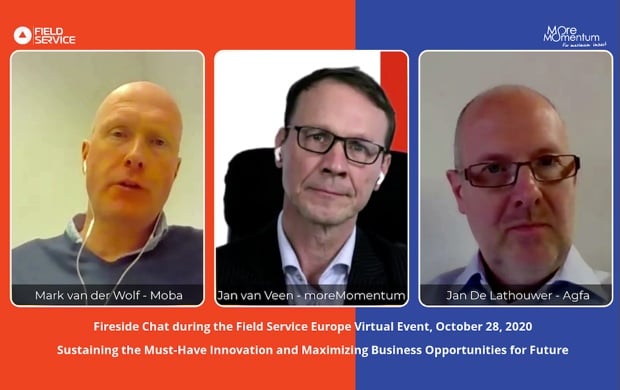Navigating Multiple Disruptive Forces in Service
In the fast-paced world of service for manufacturing companies, "disruption" has become a regular part of the lexicon. Yet, how prepared are...

With many new technologies, the question is: Disrupt or Be Disrupted. But, most are not to disrupt, but do need to know how to thrive during disruption.
In the manufacturing sector, a popular topic is the potential disruption, driven by:
And the potentially disruptive new value offerings, operating models and business models which could emerge. As manufacturers, we run the risk of missing the boat, so the question is: Disrupt or Be Disrupted? Most of the companies will not be able to disrupt but certainly need to know how to thrive in a disruptive world.
In my view, the following is required to be successful:
However, too often I see misconceptions about disruption and disruptive innovation, a lack of clarity on what needs to change and too slow a pace of change.
By consequence, manufacturers tend to make inadequate assessments and develop inadequate strategies, allowing leading competitors and new entrants into the industry to take the lead.
In this article I will focus on what disruptive innovation is, the impact and how to prevent typical pitfalls.
Disruptive innovation is a nasty beast. We have seen quite a few strong brands (almost) disappearing because of disruption, like Kodak, Nokia, IBM computers and Polaroid to mention a few.
For clarity I’d like to categorise innovation along two dimensions:
Mainstream innovations annually improve the value of products and services (including the related internal capabilities) as expected by the market. The aim is to increase our value and margins by better serving our best clients.
These innovations can be small and incremental or more radical.
Examples of incremental mainstream innovations are improved fuel consumption of cars engines, improved uptime of the equipment we sell through more reliable equipment and better maintenance.
Examples of more radical mainstream innovations are cars going electric and our services becoming more predictive and performance based.
MANUFACTURERS THAT FALL BEHIND THE COMPETITION HAVE NOT BEEN DISRUPTED YET
The majority of the manufacturing companies are too slow in driving the mainstream innovation and see leading competitors achieving higher growth rates, higher margins, more service – recurring and stable – revenue and higher customer loyalties being ahead of the game. As Jack Welsh said: “If the rate of change on the outside exceeds the rate of change on the inside, the end is near.”
Disruptive innovations break with the ongoing and upward trend of improving value.
There are two ways of disruptive innovation: offering lower value at a lower price for the low-end market or offering lower-barrier solution opening a new market segments which have not been served so far.
At the early stages, disruptive products and services serve a small niche, often at a lower value level. These solutions will follow a mainstream innovation journey, increasing value and price. Gradually the products or services become a viable alternative for a larger portion of the markets.
Examples of low-end disruptions are the low-cost airlines, which offer flights at lower service levels and lower prices. This is quite attractive for business travellers who do not want to pay a premium price for meals and convenience.
One example of new market disruptions in which a new product or service serves other needs are the PC’s, which after some time started competing against the mainframes. Another example is salesforce.com, which offered so much more flexibility and lower cost of ownership than the traditional on-premise CRM systems.
New technology enables us to develop new organisational capabilities. For example, the low-cost airlines have adopted quite different operating models which allow them to consistently fly at much lower cost and hence maintain good margins at a low price level.
For service operations, we see many manufacturers developing capabilities like remote service, connectivity, big-data and algorithms and predicting failures. These, in themselves, are not value propositions and have no value for customers. However, these can be crucial capabilities for new service propositions.
For maximum impact Focus on customer value, not on capabilities
The real impact to drive competitive value is by addressing unmet needs or barriers to use new technology or solutions with new product, services or integrated solutions. Examples are:
Besides the services and products, we can also increase value by enhancing customer experience, our brand and (lower) price levels.
At the early stages of a disruption, incumbents may see the new products and services entering their market. However, compared to business-as-usual, the new products and services are relevant for a small niche only, the market volumes are small and the added value often is much lower. Their best clients are not interested. Above that, there are so many trends and new innovations, it is hard to predict which ones will become successful.
This, together with the pressure to optimise top-line and bottom line and adequately serving our best clients, means it is easy to ignore the signs and consider them as irrelevant.
Disruption most often comes from outside your industry.
Historically it appears that often incumbents beat new entrants when it’s about mainstream innovations, as they will defend their main business with valuable clients.
However, when it’s about disruptive innovation, new entrants disrupt the industry and incumbents only start to respond (in panic) when it’s too late. The new entrants have built the knowledge, capabilities and the brand which makes it tough for incumbents to catch up in time.
In order to thrive in our disruptive world, for sure our value propositions, operating models and business models will change. However, the fundamental changes are more around how we innovate and change.
It’s mission critical for manufacturing companies to:
The pace of business innovation and change is mission-critical in our rapidly changing world. Even leading manufacturers which have consistently been ahead of the pack, now notice that with new entrants in the industry (with a DNA in data and algorithms), they need to accelerate change significantly.
The name of the game is: Adapt or Die
On fieldsevricenews.com you can find several articles of mine, summarising the 4 winning habits of the fast moving and leading companies.
How to take action
In several workshops with various businesses, we have noticed that the provided insights working with the matrix leads to valuable eye-openers. A critical success factor for all of us is constantly turning insights and knowledge into action.
I would recommend you do the following in the next 2 weeks:
This insight will help you define a compelling story about your concern and vision, with which you can start developing a shared concern and momentum within your own unit and other stakeholders in your business.
In case you would like to read more about disruptive innovation, I can recommend the eBook: How to Thrive in a Disruptive World (Jan van Veen)
Subscribe for the our Impulse Letter
With regular updates about service news, trends and best practices.

In the fast-paced world of service for manufacturing companies, "disruption" has become a regular part of the lexicon. Yet, how prepared are...

During the Field Service Europe Virtual Event of WBR, we had a Fireside Chat about How to advance digital services to thrive in disruptive times....

With today’s disruption from Covid and the economic downturn, continuing services innovation is paramount to survive and thrive. Customer needs are...